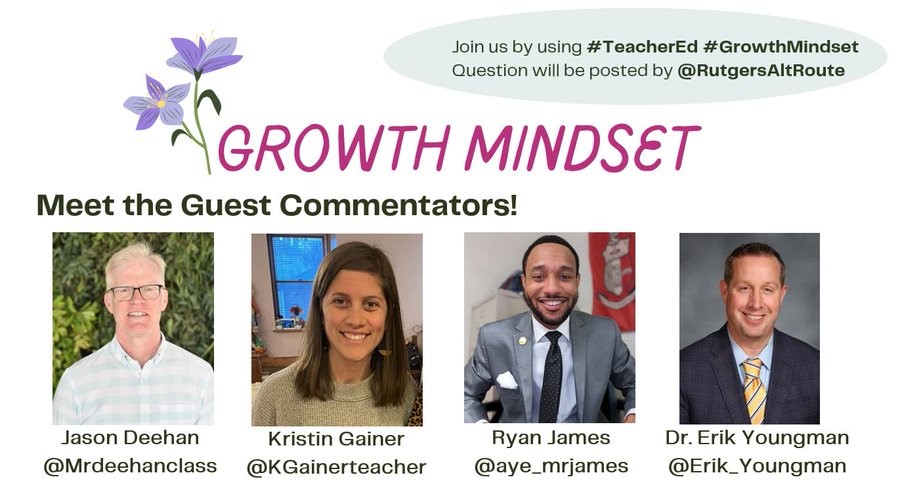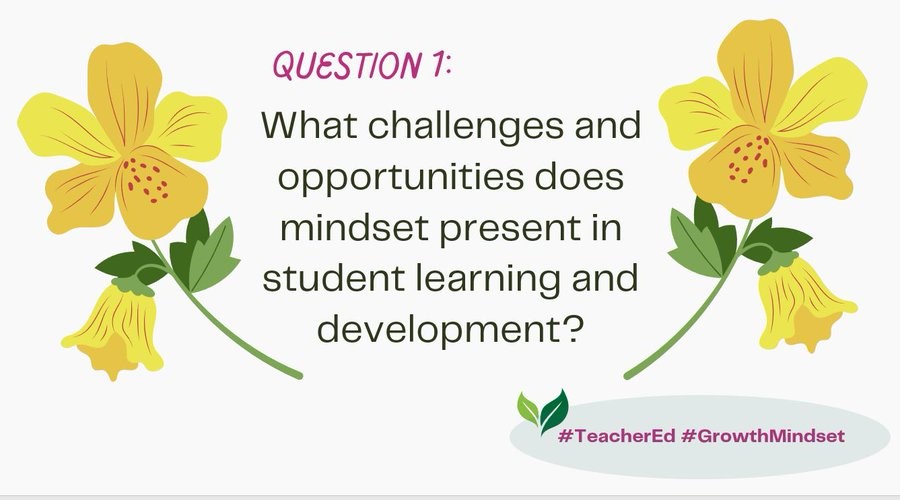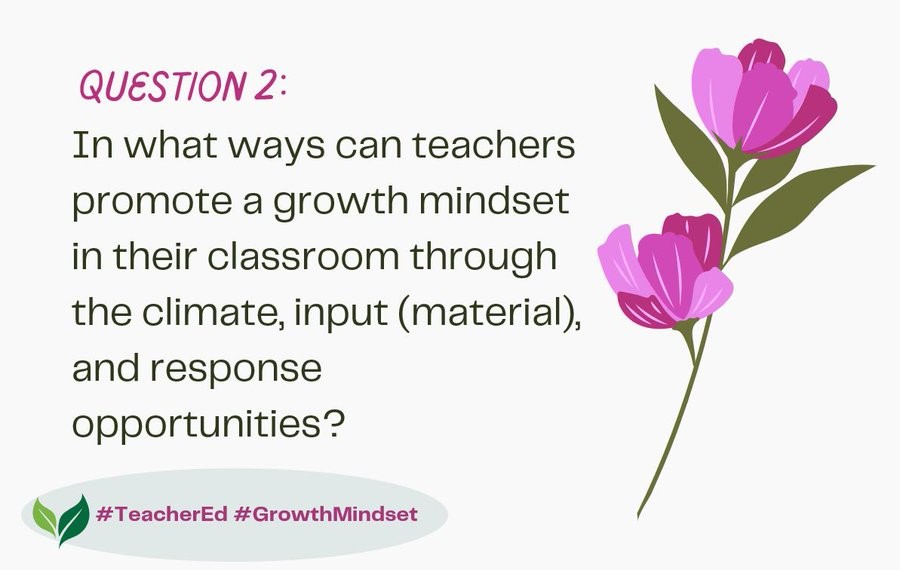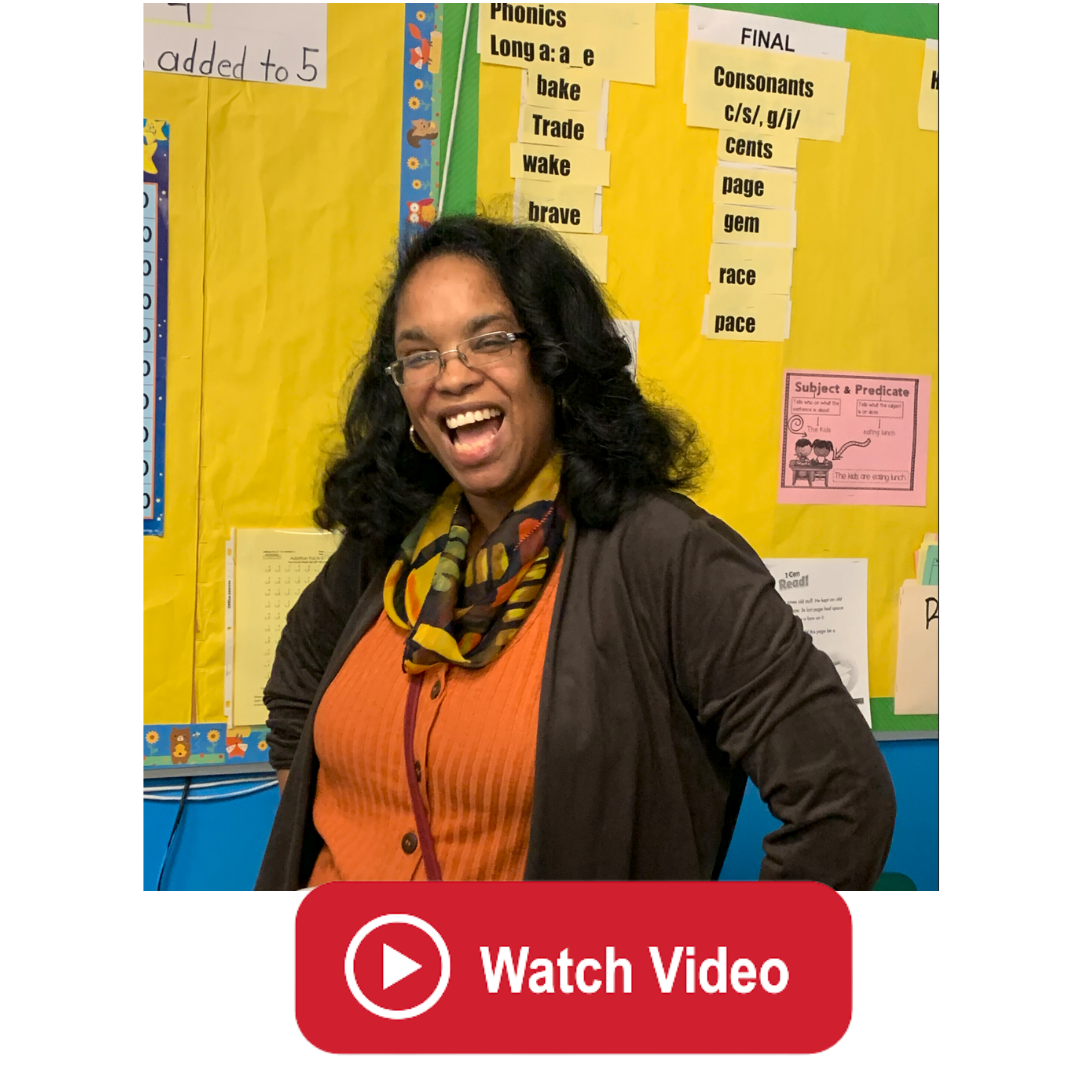New Teachers Can Unlock Student Potential Through a Growth Mindset

Stanford psychologist Carol Dweck studied students' attitudes about failure for more than 30 years, resulting in research revealing that students can significantly improve their academic capabilities, and subsequently, their scholastic outcomes through learning experiences and effort. This is known as having a growth mindset. For many teachers, this research is encouraging since their ultimate goal is to help students reach their full potential. To do that, they need to understand how students learn and grow, and how mindset figures into the learning and success equation.
New teachers enrolled at Rutgers Alternate Route recently had a social media chat about growth mindset culture. They explored the ways in which a student's beliefs about their own abilities and the nature of intelligence can either hinder or unlock their potential for growth and success. This was a great chance for them to share ideas and tips. During the chat, teachers from various subjects, grade levels, and backgrounds talked about the different ways to create a growth mindset classroom and how to inspire students to do their best.
According to a survey administered by Dr. Sharlene Laud, Assistant Director for the program, the chat helped 100% of participants feel familiar with growth mindset research. This was an improvement from before the chat, when about 13% of participants were not familiar with growth mindset research. Dr. Laud also noted that after participating in the chat, the percentage of teaching candidates who felt that they were very familiar with growth mindset research increased from about 19% to about 69%.
This 50% increase could be partially attributed to the esteemed panel of educators seasoned in the art of student success and growth mindset culture who supported the candidates as guest commentators during the chat. They included: Kristin Gainer 6th-grade teacher for Hempfield School District in Pennsylvania who has 15 years of teaching under her belt; Erik Youngman, Ed.D. Assistant Superintendent for Teaching and Learning for Libertyville District 70 in Illinois who has also been an educator for over 20 years and annual chat contributor; Jason Deehan Social Studies teacher at an international school in Pakistan, and Ryan James an 8th grade Civics/Economics teacher for Richmond City Public Schools in Virginia.

Their wisdom and insights provided a compass for navigating the complexities of fostering a growth mindset in students. As part of the panel, the guest commentators discussed concrete strategies for cultivating a growth mindset culture in their classrooms with novice teachers.
Two Mindsets Shaping Student Performance

Their wisdom and insights provided a compass for navigating the complexities of fostering a growth mindset in students. As part of the panel, the guest commentators discussed concrete strategies for cultivating a growth mindset culture in their classrooms with novice teachers.
The Barriers of Fixed Mindsets
Teachers quickly observed that no discussion of growth-mindset is complete without discussing a fixed-mindset. A fixed mindset is the belief that intelligence and abilities are static traits that can't be changed much through effort. Students with a fixed mindset are afraid to take risks or try challenging tasks for fear of failure and tend to give up easily when faced with obstacles. This mindset creates major barriers to learning, noted many teachers. Here are some responses that illustrate those challenges:
“As a high-school teacher, mindset presents challenges in students learning. A fixed mindset can hinder students' willingness to take risks and learn from mistakes, fostering a fear of failure and negative self-talk.” - @tsadikWTSD
“Student mindset is something I always struggled with as a kid. Students need to be willing to fail instead of being afraid to try. Some students avoid participating; they think that they aren’t smart or talented enough. The power of “yet” is so important!” - @mi18910
“As a third-grade teacher, mindset presents both challenges and opportunities in student learning. A fixed mindset can hinder students' willingness to take risks and learn from mistakes, fostering a fear of failure and negative self-talk.” - @Justin374323950
“One of the biggest challenges I face as a teacher in terms of mindset is when students are afraid to take a risk. So often students will not take a chance. They are so caught up on attaining a grade. They will show me their work and ask, "Will this get me an A+???"” - @Mrdeehanclass
“I can see a defeatist mindset from some challenging students: It's as if they want to pre-emptively disrupt everything to not challenge their negative feelings. It can be very distracting, of course, but it also signifies to me a kid who is vulnerable and needs attention.” - @Kafkaesque83
“Lower performing students tend to get stuck in the notion of "having" to stay lower and have a hard time envisioning a future in which they learn, do well, and excel. It's challenging to break students out of that mindset and build their confidence.” - @powergraham5000
The Power of Growth Mindsets
In contrast, a growth mindset is the belief that abilities can be developed through dedication and hard work. Students with a growth mindset see challenges as opportunities to stretch and grow their skills, persist in the face of obstacles, view them as temporary setbacks, and develop greater self-esteem, confidence, and resilience. Teachers below share examples of these strengths:
“Mindset challenges fixed beliefs, promoting growth. It offers students resilience, turning failures into learning opportunities, fostering development.” - @danielcavalier6
“It is crucial to ensure students understand that mistakes are good; they are how we learn. Once students change their mindsets, anything is possible.” - @SocciJoseph
“Having the proper mindset can change a frustrated learner into a growing learner willing to see mistakes as an opportunity for growth.” - @rshames1121
“There's an opportunity to see students grow both in what is being taught in class and how they see themselves develop as learners. Setting goals for themselves I feel is key to this.” - @KevinMaphis
“I find that keeping a growth mindset allows us to focus on building student understanding rather than focusing on student outcomes. When a student does not meet the standards for a writing assignment, the growth mindset can be when discussing revisions.” - @modthryth_
“Student mindset, especially just willingness to engage in the material, makes a world of difference in how much students get out of the class. Students open to learn, regardless of aptitude, will always have more learning opportunities.” - @concertafied
Cultivating a Growth Mindset Classroom
One of the most impactful things we can do as educators is help our students develop a growth mindset. When students believe their abilities can be developed through hard work and dedication, they become resilient learners who embrace challenges and persist through obstacles. But fostering a growth mindset requires creating the right classroom culture and using targeted strategies. How can teachers accomplish this?
Praise the Process, Not Just Results
The way we praise students has a big impact on their mindset. Instead of praising their ability, recognize their effort, strategies, and persistence. Celebrate mistakes as valuable learning opportunities, and provide meaningful feedback focused on their thinking process, not just getting the right answer. Below are some responses by our teachers that highlight methods for such praise:
“As a teacher, I can change the way I praise and the things I praise. I can make the “growth mindset” a key idea in my classroom from the very beginning. I can acknowledge and celebrate my own mistakes, and mentor risk-taking for the students.” - @perpetualsunset
“Teachers can create a growth mindset by promoting a culture of intelligent praise. It’s good to not just say the students are smart, but rather praise their efforts or hard work.” - @RakeishaWeir
“Teachers can promote a growth mindset by always planning the next task for every student, using language of praise that’s directed at the effort/persistence, as well as rewarding the thinking process instead of only seeking out the “right answer.”” - @KabbaniGSE
“Student work must be tailored to ensure learning, check for understanding, but also be presented in a way to bolster confidence with a job well done. Positive reinforcement goes a long way!” - @powergraham5000
“Some recommendations from the materials that are relevant to my classroom are praise and growth mindset in assessment. I fundamentally approach language learning as a lifelong journey, so I try to balance traditional assessments with opportunities for feedback and revision.” - @julianebil97397
Foster a Supportive Environment
Create an atmosphere of respect, inclusivity, and psychological safety where students feel comfortable taking risks. Build positive relationships by sharing personal stories to help students relate to you as their teacher. Establish classroom norms that empower a growth mindset, like using the "power of yet" phrasing. Here are some suggested examples:
“To promote growth mindset, I like to share personal stories of challenges I've overcome through effort and perseverance. At a previous school I introduced Failure Fridays where we would share stories about failure!” - @Mrdeehanclass
“As a teacher, I can create an encouraging classroom, embrace mistakes as a learning experience, and encourage the use of “yet.” Having a community for my students and giving them the tools they need to succeed can foster a positive mindset.” - @bananasbri
“Building positive relationships is essential to creating a productive classroom environment, but I also realized that students need to be able to relate to their teachers. I am transparent with my students and share personal experiences where my mistakes did not define me.” - @aye_mrjames
“Teachers should and can model positivity & respect for themselves and others in the classroom-- this will help set the tone of the classroom of inclusivity and students will definitely begin to feel more comfortable & conform to the class culture.” - @JayZonday
“Creating a positive and inclusive learning environment allows for self-motivated students to feel comfortable. Within that environment framing questions in the correct way and embracing mistakes can lead to a proper growth mindset.” - @rshames1121
Use Targeted Instructional Strategies
Model a growth mindset yourself by openly embracing challenges. Give students multiple attempts on assignments with feedback between tries. Tailor tasks to challenge each student's zone of proximal development. Grade for effort, completion, and participation over just correctness. Take a look at these examples of effective strategies:
“Set the students up for success. If a teacher can direct the questions tailored to the "sweet spot" of a student, then the student will have greater success. And, at the very least, even if the questions aren't answered perfectly, the student will feel better about the class.” - @Sjrcasey
“I start the year with the ghost buster symbol over the phrase, "not a math person". Homework (much of which can be done during class) is graded on completion, not correctness. Attempted participation is praised, right or wrong.” - @ruthsjim
“The expectation is effort over results. We speak about this continuously. Nonverbally we are always in the class trying new ideas.” - @KParagios
“I set the tone for a growth mindset on the first day of class. I explain that this will be the first time they see a lot of the material I am teaching/think in the way I will ask them to and that mistakes are expected/encouraged. All I ask is that they challenge themselves.” - @MikeMeola4
“Teachers can always tell students that they can always learn and change. Also letting students have attempts at something instead of one chance on assignments. Giving meaningful feedback to help students grow.” - @arcurem
“I like the idea of giving multiple chances on an assignment giving them different layers so they can get feedback in levels so it not so overwhelming.” - @TaitLiza
Set Up Your Classroom for Growth
Use motivating posters and displays with growth mindset phrases. Provide scaffolds like sentence starters to help students persevere through difficult tasks. Create classroom rights and rules that reinforce a growth mindset culture. Some educators illustrated what growth in their classroom looks like:
“This is one of my favorite Qs because it makes me stop to consider the different communications. I love positive posters and posters with sentence stems or ideas to get "unstuck".” - @Sharlene_Laud
“I teach a writing class, a field of study in which many students can feel intimidated (or, worse, bored). My approach is to be as positive and supportive as I can of 6th graders, and to challenge and push 8th graders so they can grow.” - @Kafkaesque83
“I have many reminders hanging in my classroom with the word “yet.” In the beginning of the school year, we read “the magical yet” which is a great way to teach primary students about growth mindset!” - @Emma55182420773
“In Social Studies, growth mindset can be encouraged while practicing evidence-based writing. I use a rubric to grade this writing and refer to it while working with my students individually. Students see where their writing is and use feedback to move forward.” - @sarahmalanga2
“In an ESL setting, it is very important for everyone to be respectful of each other, listen, and not be afraid to make mistakes because we can learn from each other’s mistakes!” - @mar5729_
“I can create an atmosphere where mistakes are viewed as opportunities to learn. I can also model self-reflections that focus heavily on strengths as well as growth opportunities, encouraging students to have confidence in their potential.” - @AlexandriaLynn_
Fostering a growth mindset is essential in education. By embracing a growth mindset, educators can dismantle fixed beliefs, cultivate resilience, and create environments where challenges are seen as opportunities for growth. Praise focused on effort, supportive classroom atmospheres, and targeted instructional strategies are key components in nurturing this mindset. The power of mindset lies in its ability to unlock boundless potential within each student, shaping a future where every learner thrives through belief in their own capabilities.
To explore the conversation or contribute your insights, search "#TeacherEd #GrowthMindset" on the X platform or check out our Wakelet that curates the chat.
Check out our previously published blog posts addressing this topic:
- Alternate Route Teacher Fosters Growth Mindsets by Gaining Students’ Trust
- Alternate Route Teacher Adopts Fail Forward Policy to Foster Growth Mindsets
- How Teachers Can Cultivate Growth Mindsets Using Assessment
- New Teachers Explore Why a Growth Mindset is Important for Both Students and Teachers
- Teachers Model Growth Mindset During Twitter Chat
- Twitter: Invaluable Tool for Teachers’ Professional Development

 Sara Hanafi is an upcoming Sophomore at Rutgers University-New Brunswick where she is working towards a degree in Cell Biology & Neuroscience. She has worked with Rutgers-GSE as a student worker-data and communications intern since March 2024. Published works by Sara are completed in collaboration with the Rutgers Alternate Route Team.
Sara Hanafi is an upcoming Sophomore at Rutgers University-New Brunswick where she is working towards a degree in Cell Biology & Neuroscience. She has worked with Rutgers-GSE as a student worker-data and communications intern since March 2024. Published works by Sara are completed in collaboration with the Rutgers Alternate Route Team. 





